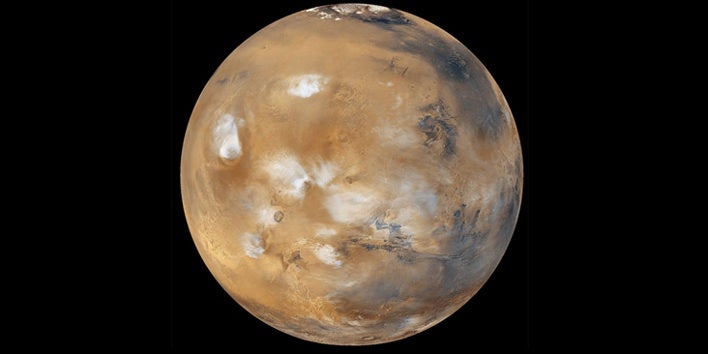Scientists Create Martian Clouds On Earth
Experiments in a sealed aluminum chamber could tell scientists more about how clouds form on Mars.

Two summers ago, in a sealed aluminum chamber in Germany, an international team of scientists created 10 Mars-like clouds. Each alien puff formed over about 15 minutes, under conditions mimicking the Red Planet’s, and the scientists never got to see them. There aren’t any windows in the chamber, so the scientists had to shoot lasers into the chamber to measure what they’d made.
From their experiments, the scientists predicted at what temperatures and humidity levels clouds are able to form on Mars. Their findings could improve mathematical models of Martian weather, which often have trouble predicting cloud formation, they wrote in a paper published in the Journal of Geophysical Research: Planets.
So how do you make a Martian cloud on Earth? Here’s what the team did:
They pumped out all of the oxygen out from the cloud chamber at the Aerosol Interaction and Dynamics in the Atmosphere (AIDA) facility in Karlsruhe. The chamber is 22,000 gallons (84.5 meters3) in volume and has adjustable temperature, pressure and humidity. Scientists usually use it to study high-altitude cirrus and polar stratospheric clouds that appear on Earth.
The research team pumped into AIDA either inert nitrogen or carbon dioxide, the most common gases in Mars’ atmosphere.
They blew in bits of dust that are of a similar size and material as Martian dust. Just as on Earth, Martian clouds form around grains of dust, which act as the clouds’ nuclei.
They turned down the temperature in AIDA, gradually lowering it from about -81 degrees Fahrenheit, the lowest temperature at which clouds are known to form on Earth, to -120 degrees Fahrenheit, which would count as a warm day on Mars. It’s also just about as cold as AIDA can get. The researchers kept the pressure low, as in Mars’ atmosphere, and tried different humidities, to see which combinations of conditions would form clouds.
They crisscrossed the chamber with lasers to measure what was happening inside. Any cloud formation should interfere with the passage of light through the chamber.
The team found that at lower temperatures, they needed very high humidities to form clouds. The team isn’t sure why Mars clouds require such high humidities, the team’s lead scientist, Daniel Cziczo of MIT, told MIT News. They want to perform more experiments to find out.
AIDA will now undergo renovations that will allow researchers to turn down its temperatures even further. Cziczo’s team will be back next year to try to make clouds in a temperature range that’s closer to Mars’.